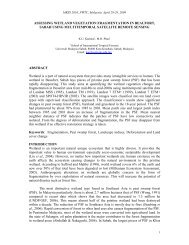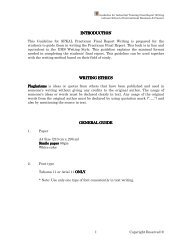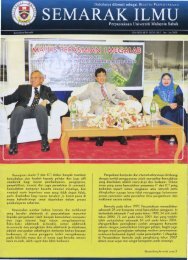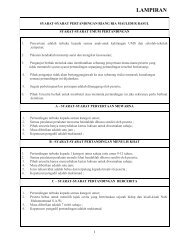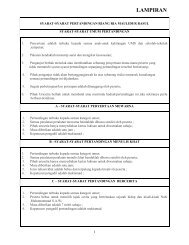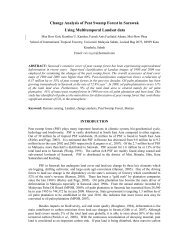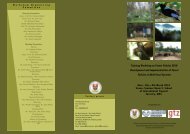Report for the German Agency for Technical Cooperation (GTZ) - UMS
Report for the German Agency for Technical Cooperation (GTZ) - UMS
Report for the German Agency for Technical Cooperation (GTZ) - UMS
Create successful ePaper yourself
Turn your PDF publications into a flip-book with our unique Google optimized e-Paper software.
Output of step two<br />
Private sector and local government as well as policy makers have an in<strong>for</strong>mation about <strong>the</strong><br />
financial review of <strong>the</strong> REDD program and its competitiveness with palm oil program<br />
The willingness of local government and private sectors to be involved in REDD program will<br />
be identified.<br />
Research methods will be fur<strong>the</strong>r developed<br />
Rita Diana<br />
Research Proposal 1: CO2 uptake and carbon balance in <strong>the</strong> tropical rain <strong>for</strong>est (secondary<br />
<strong>for</strong>est and <strong>for</strong>est plantation)<br />
Introduction<br />
The knowledge of <strong>the</strong> sources and sinks of carbon dioxide (CO2) is not sufficient. Recently,<br />
<strong>the</strong> estimations of CO2 fluxes in <strong>the</strong> temperate <strong>for</strong>ests have been begun to appear in<br />
publications. While <strong>the</strong>re are few data in <strong>the</strong> tropical area where absorption of carbon dioxide<br />
by <strong>for</strong>ests seem to large. Especially, <strong>the</strong>re is no long-term data in Kalimantan. This makes<br />
difficult to estimate CO2 balance in <strong>the</strong> global scale. Our purpose is estimate CO2 balances<br />
in <strong>the</strong> secondary <strong>for</strong>est and plantation <strong>for</strong>est which occupy relatively large areas in <strong>the</strong><br />
tropical regions especially in Kalimantan.<br />
Objectives<br />
The purpose of this research is to conduct <strong>the</strong> CO2 flux measurements at most through <strong>the</strong><br />
several years, and estimate <strong>the</strong> production by photosyn<strong>the</strong>sis of <strong>the</strong> growing secondary<br />
<strong>for</strong>est and plantation <strong>for</strong>est. The correlation method will be used <strong>for</strong> estimating CO2<br />
absorption and emission. Recent studies have shown CO2 flux is highly sensitive to ambient<br />
environmental parameters, such as, solar radiation, temperature, humidity, and o<strong>the</strong>rs.<br />
There<strong>for</strong>e, we can understand <strong>the</strong> structure of photosyn<strong>the</strong>sis of community by clarifying <strong>the</strong><br />
relations between CO2 flux and ambient parameters. Ano<strong>the</strong>r purpose is to present a way to<br />
parameterize <strong>the</strong> carbon balance in order to understand <strong>the</strong> role of <strong>the</strong> factors controlling <strong>the</strong><br />
carbon budget of <strong>the</strong> tropical secondary <strong>for</strong>est and plantation <strong>for</strong>est ecosystem.<br />
Methodology CO2 concentration is measured by CO2 analyzer CO2 flux is measured by eddy<br />
correlation method which is a combination of CO2 concentration and vertical velocity<br />
fluctuations. CO2 concentration and vertical wind velocity are measures on <strong>the</strong> plat<strong>for</strong>m over<br />
<strong>the</strong> canopy layer, using 30-m tower located in tropical secondary <strong>for</strong>est. Decomposition of<br />
CO2 in <strong>the</strong> soil is measured by <strong>the</strong> gas chronometer. Growing rate of biomass, and litterfall is<br />
measured by tree enumeration. Photosyn<strong>the</strong>tic analysis is made to clarify <strong>the</strong><br />
ecophysiological process in <strong>the</strong> growing secondary <strong>for</strong>est. The plat<strong>for</strong>m is also used to<br />
monitor <strong>the</strong> relevant meteorological conditions; wind speed and direction, temperature and<br />
humidity, precipitation, photon flux density and net radiation, water content, soil temperature,<br />
etc.<br />
Concepts<br />
CO2 is most important global warming compounds. CO2 flux observed above canopy is NEP<br />
(Net Ecosystem Production) which is important <strong>for</strong> estimating of global warming in tropical<br />
area, where very few data are obtained. Net Primary Production NPP, Gross Primary<br />
Production GPP, Respiration R will be estimated by observed NEP, observed soil respiration,<br />
and measured biomass increment. These ecological parameters of community are related<br />
with meteorological conditions, including heat balance, water cycle and CO2 budget.<br />
Research Proposal 2: Proposal of Carbon stocks in Secondary <strong>for</strong>est and Plantation <strong>for</strong>est<br />
Background<br />
Tropical rain <strong>for</strong>est has played an important role on carbon accumulation throughout of<br />
photosyn<strong>the</strong>tic activity of it diverse species and vegetation. There are various vegetation of<br />
tropical rain <strong>for</strong>est both naturally and artificially type with different level of carbon gain<br />
capability. However, <strong>for</strong>est deflation has lead decreasing capacity of its carbon dioxide<br />
absorption. Even though, regeneration has been made through manual as well as<br />
50



